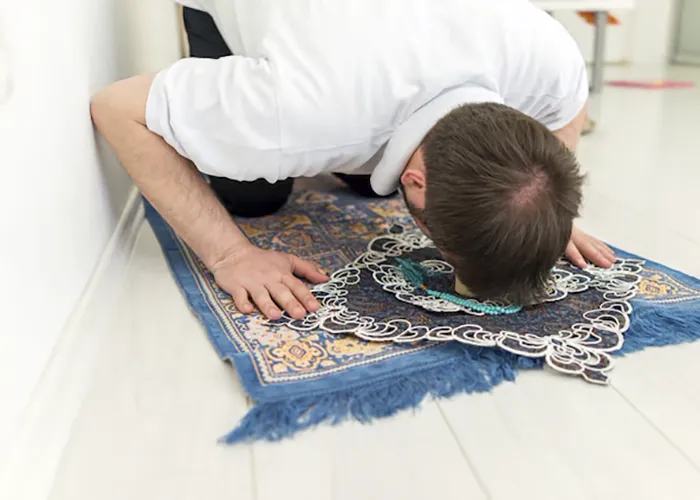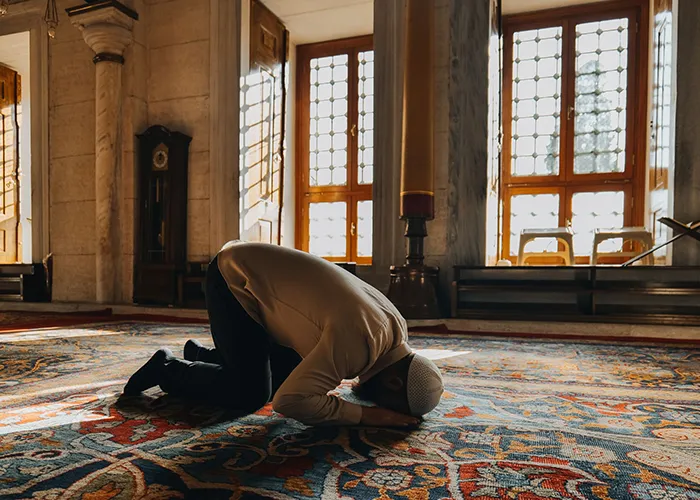Fatwa Panel of the Week – Volume02 Issue45
Obligatory Acts of Prayer
According to the fatwas of the Grand Religious Authorities: Ayatollah Sayyed Ali Khamenei, Ayatollah Sistani, and Ayatollah Makarem Shirazi (may Allah prolong their blessings).
Fatāwā presented without citing a differing opinion or a specific reference are the common rulings shared by the three respected Marāji‘. In cases where the ruling of one Marjaʿ differs from that of the other two, it is indicated in a footnote under the same number, mentioning the Marjaʿ by name.
Obligation of keeping body still in Prostration (Sajdah)
1. One should keep one’s body still while reciting the obligatory remembrance of Allah (dhikr) in the prostration (Sajdah). Moreover, by way of obligatory precaution, one should keep the body still while reciting the recommended (mustaḥab) remembrance of Allah (dhikr) with the intention that it is recommended (mustaḥab) to say during prostration (sajdah), such as the repetition of “subḥāna rabbī al‘alā wa biḥamdih”.
Ayatollah Sistani: While performing sujūd, the body of one performing salaat must be still, and one must not intentionally move one’s body in a manner that it is no longer still, even when – based on obligatory precaution – when one is not saying an obligatory dhikr.
2. If one knows one must keep one’s body still while uttering the obligatory remembrance of Allah (dhikr) of prostration (sajdah) but intentionally recites the remembrance of Allah (dhikr) of prostration (sajdah) before one’s forehead is on the ground or before one’s body becomes still, one’s prayer is invalid.
3. If one unintentionally recites the remembrance of Allah (dhikr) of prostration (sajdah) before one’s forehead is on the ground or before one’s body becomes still but realizes it while in the prostration (sajdah) position, one must repeat the obligatory remembrance of Allah (dhikr) after one’s body becomes still.
4. After raising one’s head from prostration (sajdah), if one realizes that one has said the remembrance of Allah (dhikr) before one’s forehead was on the ground or one’s body had become still, or if one has raised one’s head from prostration (sajdah) before completing the obligatory remembrance of Allah (dhikr), the prayer is valid.
5. There is no problem in prostrating on a mattress or the like, where the body is not still at the beginning but becomes still, if one says the remembrance of Allah (dhikr) while the body is still.
Ayatollah Sistani: If a person performs sajdah on a feather mattress or a similar thing similar and the body does not stay still, it is invalid.
Ayatollah Makārim Shīrāzī: Prostrating on something upon which the body does not remain steady is problematic. However, as we have previously stated, if a person can observe the obligatory parts of prayer while in motion—such as on a ship, train, or the like— one’s prayer is valid. If one prostrates on a mat or another surface where the body is initially unstable but later becomes steady, there is no problem.
6. If a person intentionally lifts one of the seven body parts while uttering the remembrance of Allah (dhikr) in prostration (sajdah), the prayer becomes invalid; if, however, one lifts a body part (other than the forehead) and puts it back down again when one is not uttering the remembrance of Allah (dhikr), there is no problem.
Ayatollah Sistani: If while saying the dhikr of sajdah one intentionally raises one of the seven parts of the body from the ground, and if this is inconsistent with the requirement for the body to be still in sujūd, the prayer is invalid. The same applies, based on obligatory precaution when one is not saying the dhikr.
7. If one inadvertently lifts one’s forehead before the remembrance of Allah (dhikr) of prostration (sajdah) has finished, one cannot put it down again but should count it as performance of one prostration (sajdah). If one inadvertently lifts other parts of the body, one should put them down again and utter the remembrance of Allah (dhikr).
8. If in the process of prostrating (sajdah), one’s forehead hits the place of prostration (sajdah) and the praying person inadvertently lifts it from the ground, they should put it down again and utter the remembrance of Allah (dhikr) of prostration (sajdah), and this is counted as one prostration (sajdah).
9. After finishing the remembrance of Allah (dhikr) of the first prostration (sajdah), the praying person should sit until their body becomes still and then perform the second prostration (sajdah).
The ruling on the organs of prostration in a state of necessity (iḍṭirār).
1. In prostration (sajdah), one should place both palms on the ground. However, in the case of necessity, there is no problem in putting the back of the hand on the ground, and if that is not possible, one should put one’s wrists on the ground. If this, too, is not possible, one should put a part of one’s forearm on the ground. In case that it is not possible, it suffices to put any part of the arm on the ground.
2. If, owing to a disease or the like, one is not able to remain in the prostration (sajdah) position long enough to say “subḥānallāh” three times, it is sufficient for one to say “subḥānallāh” once. If one can only remain in the prostration (sajdah) position for a moment, by way of obligatory caution, one should begin saying the remembrance of Allah (dhikr) at that moment and finish it while raising one’s head from the prostration (sajdah) position.
3. If a person cannot place one’s forehead on the ground, one should bend as much as possible and place the prostration cube (turbah) or anything on which prostration (sajdah) is permissible on a higher place so that one’s forehead can reach it in a manner that it is commonly called prostration (sajdah). However, one must place one’s palms, knees, and the tips of their big toes on the ground as usual if possible. If there is nothing to put the prostration cube (turbah) on, one should raise the prostration cube (turbah) with one’s hands and place one’s forehead on it.
If one cannot bend at all, one should instead make a head gesture indicating prostration (sajdah), and if that is not possible, either one should indicate performing prostration (sajdah) with one’s eyes.
editor's pick
news via inbox
Subscribe to the newsletter.




